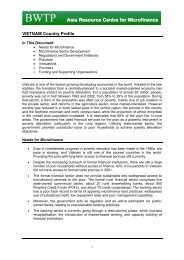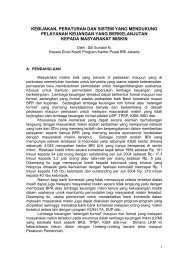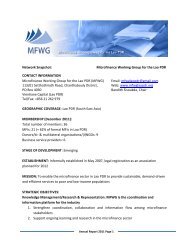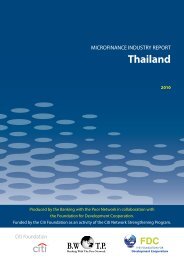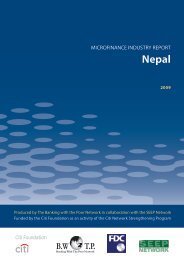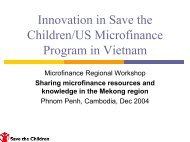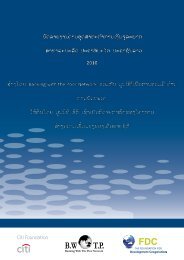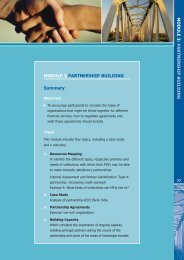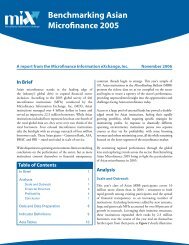Rural Self ?Reliance Fund (RSRF): - Banking with the Poor Network
Rural Self ?Reliance Fund (RSRF): - Banking with the Poor Network
Rural Self ?Reliance Fund (RSRF): - Banking with the Poor Network
You also want an ePaper? Increase the reach of your titles
YUMPU automatically turns print PDFs into web optimized ePapers that Google loves.
<strong>Rural</strong> <strong>Self</strong> -<strong>Reliance</strong> <strong>Fund</strong> (<strong>RSRF</strong>):<br />
An Innovative Approach in Micro-finance<br />
A. Background:<br />
- K.K. Pradhan* *<br />
The establishment of <strong>Rural</strong> <strong>Self</strong>-<strong>Reliance</strong> <strong>Fund</strong> (<strong>RSRF</strong>) was an innovative step<br />
towards developing <strong>the</strong> micro-finance industry. The <strong>Fund</strong> was setup by HMG of<br />
Nepal in Feb. 1991 through Cabinet decision. HMG/N had initially allocated Rs.10<br />
million as a corpus amount to <strong>the</strong> <strong>Fund</strong>, which later increased to Rs.20 million to be<br />
disbursed for <strong>the</strong> income-generating activities to uplift <strong>the</strong> economic condition of <strong>the</strong><br />
poorest of <strong>the</strong> poor and deprived sector people who lacks <strong>the</strong> access to formal<br />
financial institutions. <strong>RSRF</strong>, since <strong>the</strong>n, has been actively engaged in <strong>the</strong> upliftment of<br />
<strong>the</strong> poorer and weaker section of <strong>the</strong> remote and rural areas by providing wholesale<br />
micro-credit to Savings and Credit Co-operatives (SACCOPs) and Non-governmental<br />
Organization (NGOs) operating in <strong>the</strong> rural areas. The <strong>Fund</strong> is <strong>the</strong> first wholesale<br />
institution in micro-finance sector and also an innovative approach to help promote<br />
<strong>the</strong> rural-based co-operatives and NGOs that are supposed to uplift <strong>the</strong><br />
socio-economic condition of <strong>the</strong> poorest of <strong>the</strong> poor. The <strong>Fund</strong> was created in such a<br />
situation where not a single formal micro-finance institution was in existence. <strong>Poor</strong><br />
people were lacked behind by <strong>the</strong> access of commercial banks and Agricultural<br />
Development Bank of Nepal (ADB/N). Service provided by <strong>the</strong>se two institutions was<br />
not sufficient enough to serve <strong>the</strong> rural people. The decades old Priority Sector Credit<br />
Program of <strong>the</strong> commercial banks also could not reach out to <strong>the</strong> weaker people<br />
through small credit. Quite a number of co-operatives and NGOs, wishing to serve <strong>the</strong><br />
local people were also deprived of <strong>the</strong> resources for lending to <strong>the</strong>ir members. Thus, a<br />
great need was felt in improving <strong>the</strong> credit-delivery mechanism of cooperatives and<br />
NGOs such that <strong>the</strong> poorer, weaker and deprived sector people of <strong>the</strong> remote villages<br />
would benefit at large. <strong>RSRF</strong>, since its inception, has been playing a pro-active role in<br />
<strong>the</strong> promotion and development of <strong>the</strong> resources of <strong>the</strong> SACCOPs and NGOs through<br />
<strong>the</strong> wholesale funding program. This has been reflected into its performances of <strong>the</strong><br />
past 13 years.<br />
B. Organizational setup and Operation of <strong>RSRF</strong>:<br />
As per <strong>the</strong> decision of HMG/N <strong>the</strong> operation of <strong>the</strong> <strong>Fund</strong> is carried out by <strong>the</strong> Board of<br />
Directors constituted under <strong>the</strong> chairmanship of <strong>the</strong> Deputy Governor of Nepal Rastra<br />
Bank. The Board presently consists of:<br />
1. Deputy Governor, Nepal Rastra Bank - Chairman<br />
2. Joint-Secretary, Ministry of Finance, HMG/N - Member<br />
3. Joint-Secretary, Ministry of local Development - “<br />
4. Mr. Bhim Bdr. Adhikary (Founder-Member) - “<br />
5. Executive Director, Micro Finance Dept., NRB - Member-Secretary<br />
The secretariat of <strong>the</strong> <strong>Fund</strong> is located at MFD, NRB that has given full responsibility<br />
to perform and manage <strong>the</strong> operation of <strong>the</strong> fund. A separate wing has been set-up in<br />
MFD for <strong>the</strong> day-to-day operation of <strong>the</strong> <strong>Fund</strong> where 2 officers & 4 senior Assistants<br />
are assigned to carry out <strong>the</strong> <strong>Fund</strong>'s activities. Similarly, various activities like prefeasibility<br />
study and inspection of loan utilization are being carried-out by <strong>the</strong> staffs of<br />
NRB's district offices located outside Kathmandu valley. With this mechanism <strong>the</strong><br />
Paper Presented at a Seminar Jointly Organized by CMF and BWTP on "Sharing Micro-finance Resources and Knowledge in<br />
South Asia" on 27th March 2004.<br />
* Executive Director, Micro Finance Department, Nepal Rastra Bank and Member-Secretary <strong>RSRF</strong>.<br />
1
loan-application of <strong>the</strong> partner organization can be processed promptly. The Board is<br />
solely responsible for any activities of <strong>the</strong> <strong>Fund</strong> including <strong>the</strong> decision on <strong>the</strong> loan<br />
proposal. However, <strong>the</strong> Board has delegated its authority to <strong>the</strong> committee and<br />
subcommittee constituted for this purpose.<br />
Likewise, a long-term credit committee, known as technical committee, has also been<br />
constituted in <strong>the</strong> credit manual of <strong>RSRF</strong>. This committee can sanction loan up to Rs.5<br />
million.<br />
The sanctioned loan amount is distributed through <strong>the</strong> bank's accounts only.<br />
Disbursement and repayment of <strong>the</strong> loan is also made through <strong>the</strong> offices of NRB<br />
situated out-side Kathmandu valley. NRB, in <strong>the</strong> transaction, does not charge any fees<br />
and commissions.<br />
C. Objectives of <strong>RSRF</strong>:<br />
With <strong>the</strong> recent amendment in objectives and areas of operation of <strong>the</strong> <strong>Fund</strong>, <strong>RSRF</strong><br />
has laid down <strong>the</strong> following 3 objectives:<br />
1. To mobilize seed capital received from HMG/N and NRB and o<strong>the</strong>r donor<br />
agencies for involving rural poor and deprived group in income generating<br />
credit activities through co-operatives, NGOs and o<strong>the</strong>r specific financial<br />
institutions.<br />
2. To provide longer tern credit to ADB/N for Tea and Cardamom plantation and<br />
processing, Cold Storage and Wholesale credit to MFDBs for on-lending to<br />
micro-finance activities to <strong>the</strong> rural-deprived sector people.<br />
3. To perform o<strong>the</strong>r functions for supplementary socio-economic development of<br />
<strong>the</strong> deprived sector people.<br />
D. Resources of <strong>RSRF</strong>:<br />
<strong>RSRF</strong>, at present has two major resources:<br />
4. Corpus fund (Rs.20 million) received from HMG/N in <strong>the</strong> year 1991 and 1992.<br />
This amount is utilized for <strong>the</strong> credit requirement of SACCOPs, and NGOs.<br />
5. Seed capital received from NRB, which has deposited Rs.100 million in <strong>the</strong><br />
year 2001/2002 out of its profit and also adopted a policy of depositing 5<br />
percent amount to <strong>the</strong> <strong>Fund</strong> out of its profit annually. Such amount will mainly<br />
be utilized for full filling <strong>the</strong> second objective of <strong>the</strong> <strong>Fund</strong>, stated above.<br />
Besides this, <strong>RSRF</strong> may also accept donor's fund that is directed towards uplifting <strong>the</strong><br />
economic status of <strong>the</strong> rural deprived sector people. For example, CGISP loaned by<br />
ADB/Manila and supported by CIDA. The credit component of <strong>the</strong> project CGISP is<br />
presently carrying out by <strong>RSRF</strong>. Similarly, HMG/N has also committed to allocate<br />
sufficient amount to cater <strong>the</strong> longer-term credit need of <strong>the</strong> ADB/N and savings and<br />
credit co-operatives and NGOs, which are operating in <strong>the</strong> far and remote places.<br />
E. Target Group of <strong>RSRF</strong>:<br />
<strong>RSRF</strong> has targeted <strong>the</strong> following groups and individuals for its wholesale lending to<br />
SACCOPs and NGOs.<br />
1. Individual having less than a hector of land.<br />
2. Individual <strong>with</strong> no regular income that can not feed himself and his family<br />
throughout <strong>the</strong> year.<br />
2
3. Dalit, backward caste and scheduled caste.<br />
4. Deprived sector women.<br />
5. Member of <strong>the</strong> self-reliant group of deprived sector.<br />
F. <strong>RSRF</strong> Loan Types, Size and Limit of Loan:<br />
<strong>RSRF</strong> provides three types of loan to its partner organization as under:<br />
1. Wholesale loan to SACCOPs and NGOs for providing micro-credit to <strong>the</strong>ir<br />
members.<br />
2. Longer-term loan to ADB/N for providing capital resources to Tea and<br />
cardamom, cultivation and processing, cold storage etc.<br />
3. Wholesale medium term loan to MFDBs for on lending to deprived sector.<br />
Such MFDB should be based on rural areas and perform micro-credit<br />
activities only.<br />
Loan Size:<br />
Under category 1 stated above, <strong>the</strong> maximum loan size for <strong>the</strong> SACCOPs and NGOs<br />
is Rs.1 million for <strong>the</strong> first loan, Rs.1.5 million for <strong>the</strong> second loan and Rs.2.5 million<br />
for <strong>the</strong> last loan. But such loan limit should not exceed to 10 times of <strong>the</strong>ir regular<br />
savings and share capital for <strong>the</strong> first and second loan and 15 times for <strong>the</strong> third loan.<br />
Under category 2, no maximum limit has been fixed. But it depends upon <strong>the</strong> business<br />
plan submitted by <strong>the</strong> ADB/N for <strong>the</strong> purpose specified. Likewise under category 3,<br />
wholesale loan to MFDBs is restricted to Rs.10 million only.<br />
Individual Credit Limit to Borrowers:<br />
SACCOPs and NGOs may provide micro-credit to <strong>the</strong>ir member clients as under out<br />
of <strong>the</strong> loan sanctioned by <strong>RSRF</strong>.<br />
First Loan:-<br />
Rs. 30,000 maximum per borrower<br />
Second Loan:- Rs. 35,000 “ “<br />
Third Loan:- Rs. 40,000 “ “<br />
Group/Joint Micro-enterprises Loan:- Rs. 100,000 per scheme/Group<br />
<strong>Fund</strong>ing Policy:<br />
<strong>RSRF</strong> finances only 80 percent of <strong>the</strong> total loan sanctioned. Remaining 20 percent<br />
should be financed by <strong>the</strong> partner organization. This policy is applied for longer term<br />
and wholesale loan also.<br />
G. Interest Rate Policy:<br />
<strong>RSRF</strong> has kept its interest rate on wholesale credit as under: (1) 8 percent per annum<br />
for SACCOPs and NGOs, (2) Interest rate for <strong>the</strong> longer term and wholesale loan to<br />
MFDBs is kept at par <strong>with</strong> <strong>the</strong> lowest re-finance rate of NRB i.e. maximum of 4.5<br />
percent per annum.<br />
Calculation of interest is based on 30 days a month and 360 days a year. Interest<br />
payment to <strong>RSRF</strong> is to be made on half-yearly basis. A grace period for 6 months is<br />
also provided to all SACCOPs and NGOs for <strong>the</strong> first installment of any loan. No<br />
interest is charged during this period.<br />
Likewise, Partner organizations of <strong>RSRF</strong> are free to fix <strong>the</strong>ir interest rate based on<br />
market prices.<br />
3
H. Credit Approval Priority for SACCOPs and NGOs:<br />
<strong>RSRF</strong> has adopted <strong>the</strong> following priority criteria while accepting <strong>the</strong> loan-proposal<br />
from SACCOPs and NGOs:<br />
1. Area under poverty mapping of National Planning Commission.<br />
2. Area where <strong>the</strong>re is no bank and financial institutions.<br />
3. Area where majority of 'Dalit' and depressed caste and tribes lives.<br />
4. Organizations (SACCOPs and NGOs) situated in rural area.<br />
I. Some Important Criteria to be met by <strong>the</strong> SACCOPs and NGOs to get Wholesale<br />
fund from <strong>RSRF</strong>:<br />
(1) Organization must be registered under <strong>the</strong> prevailing legal framework (e.g.<br />
Co-operative Act- 1992 and Society Registration Act- 1979).<br />
(2) Organization must have <strong>the</strong> provisions of savings mobilization and credit<br />
expansion and resource collection.<br />
(3) An experience of at-least one year for savings mobilization, where at least 70<br />
percent member should have a record of regular savings.<br />
(4) 20 percent of <strong>the</strong> total out-standings for <strong>the</strong> first loan and 10 percent for <strong>the</strong><br />
2nd and 3rd loan should not exceed status of overdue loan.<br />
(5) Organization must adopt double entry bookkeeping system and <strong>the</strong> external<br />
auditor must audit its financial statement.<br />
(6) Independent in making loan decision, etc.<br />
J. Inspection, Supervision and Monitoring by <strong>RSRF</strong>:<br />
<strong>RSRF</strong> regularly carries out inspection, supervision and monitoring of <strong>the</strong> POs that<br />
have taken loan from <strong>the</strong> <strong>Fund</strong>. Likewise it conducts pre-feasibility inspection of <strong>the</strong><br />
project once it received application for <strong>the</strong> wholesale credit. On <strong>the</strong> basis of such<br />
report <strong>the</strong> <strong>Fund</strong> ei<strong>the</strong>r rejects or approves <strong>the</strong> loan.<br />
K. Achievement of <strong>RSRF</strong> (As of Mid-Oct. 2003):<br />
Progress made by <strong>the</strong> <strong>RSRF</strong> during <strong>the</strong> last 12 years is presented below:<br />
* Total Loan Amount Ms. million)<br />
Sanctioned 79.3<br />
Disbursed 63.3<br />
Repaid 44.8<br />
Outstanding 18.5<br />
* Repayment Rate (in Percent)<br />
SACCOPs 94.6<br />
NGOs 88.0<br />
* Outreach (In No.)<br />
District Covered 44<br />
Total Client Organization 196<br />
-SACCOPs 147<br />
-NGOs 49<br />
Beneficiary Member - Clients (family) 8,496<br />
Population covered 48,000<br />
4
L. Conclusion:<br />
Although a number of licensed banks and financial institutions, 1 are in operation,<br />
people of <strong>the</strong> far and remote places are still lacking of <strong>the</strong> financial services. Likewise,<br />
thousands of co-operatives and NGOs are also operating in <strong>the</strong> country. However,<br />
<strong>the</strong>ir outreach to <strong>the</strong> below-poverty level people is found negligible. Apart from this,<br />
people living <strong>the</strong> below poverty line in <strong>the</strong> rural areas have no access to <strong>the</strong> formal<br />
financial institutions, banks in particular, because of many reasons. Thus, <strong>the</strong> presence<br />
of such noble institution like <strong>RSRF</strong> is highly deserve to exist to uplift not only <strong>the</strong><br />
savings and credit co-operatives and NGOs operating in rural areas but also to help<br />
support <strong>the</strong> socio-economic condition of <strong>the</strong> member-clients of <strong>the</strong>se institutions<br />
through micro-credit. Because of <strong>the</strong> provision of 'Administrative Grants' that <strong>RSRF</strong><br />
provides to those SACCOPs and NGOs having cent percent repayment rate to <strong>RSRF</strong>,<br />
opportunities to grow up a newly established SACCOPs and NGOs in <strong>the</strong> rural areas<br />
are enormous. Such 'administrative grants' can be utilized by <strong>the</strong>se institutions as an<br />
incentive to build up <strong>the</strong>ir capacities.<br />
Despite its limited resources (Rs.20 million) <strong>the</strong> progress so far achieved by <strong>the</strong> <strong>Fund</strong><br />
is well noteworthy. The coverage of <strong>RSRF</strong> is also highly satisfactory that out of <strong>the</strong> 75<br />
districts of <strong>the</strong> country it has covered 46 districts (as of mid-Feb. 2004) which have<br />
reflected its supportive role towards rural micro-finance. With regard to its limited<br />
resources available central bank of Nepal (NRB) has adopted a policy of allocating 5<br />
percent amount each year to <strong>the</strong> <strong>RSRF</strong> out of its profit which fur<strong>the</strong>r streng<strong>the</strong>ned and<br />
enlarged <strong>the</strong> activities of <strong>RSRF</strong>.<br />
Kathmandu, Nepal<br />
February 27 2004<br />
*******<br />
1<br />
As of mid-February 2004,17 Commercial Banks, 58 Finance Companies, 23 Development Banks, 34 Co-operatives for<br />
Limited <strong>Banking</strong> and 44 FINGOs are operating in <strong>the</strong> country<br />
5



